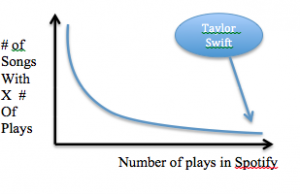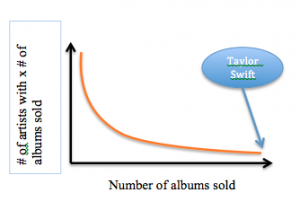Effectiveness of Spotify on Popularity (Using Power-Laws)
Recently, Taylor Swift announced that she would be taking off all her music from Spotify. Big Machine Records, her record company, pulled her content off of Spotify without negotiating with them. Swift and her record company’s justification was that Spotify pay artists a very low royalty payment, while fans get disproportional access to their free music. To give a little background on Spotify’s twofold business model: First, the free service is compensated with revenue from advertisements and second, the premium subscriptions. Artists get their royalties based on how often their music is played. However, much like Swift, many artists feel these royalties are too low. Spotify’s CEO responded that her royalties would grow over time as her songs were played more and more, rather than just selling her albums.
Putting aside ethical implications of priced royalties, Spotify may be wrong about Swift’s long-term gains from their royalties. From the perspective of power-laws, popularity in terms of Spotify’s business model can be represented as done below:
The x-axis represents the number of “song plays” on Spotify and the y axis represents the number of songs with x number of “plays”. Therefore, there are a high number of songs with a low number of “plays” and a low number of songs with a high number of “plays”.
The x-axis represents the number of albums sold and the y-axis represents the number of artists who sold x number of albums. Therefore, there are a high number of artists with a low number of their albums sold and a low number of artists with a high number of their albums sold.
Both examples show how the power-law equation can represent popularity. Popularity is represented by the small number of songs with a lot of “plays” (Spotify power-law model) and represented by the small number of artists with a lot of albums sold. The two power-law models are related in that if an artist is popular based on the number of physical albums they sell, they will most likely be popular based on the number of Spotify downloads. Based on Swift’s new album statistics, she lies in the on the far right of the album-artist graph because she’s reached a high level of popularity; therefore, she automatically lands towards the far-right of the Spotify power-law graph. Because she already has reached a level of popularity, the benefits of Spotify are rendered fruitless for her. She gets virtually no benefits from cascading information effects from Spotify because most people on Spotify are aware of her. On the other hand, Spotify helps those who are on the far-left of the power law graph because the majority of artists have many songs that are not downloaded often. Therefore, Spotify offers these artists potential exposure, which can push them past the tipping point. But for Swift, she is already passed the tipping point for popularity, therefore Spotify is of little benefit for her.
http://www.rollingstone.com/music/news/taylor-swift-abruptly-pulls-entire-catalog-from-spotify-20141103
https://news.spotify.com/se/2014/11/11/2-billion-and-counting/


